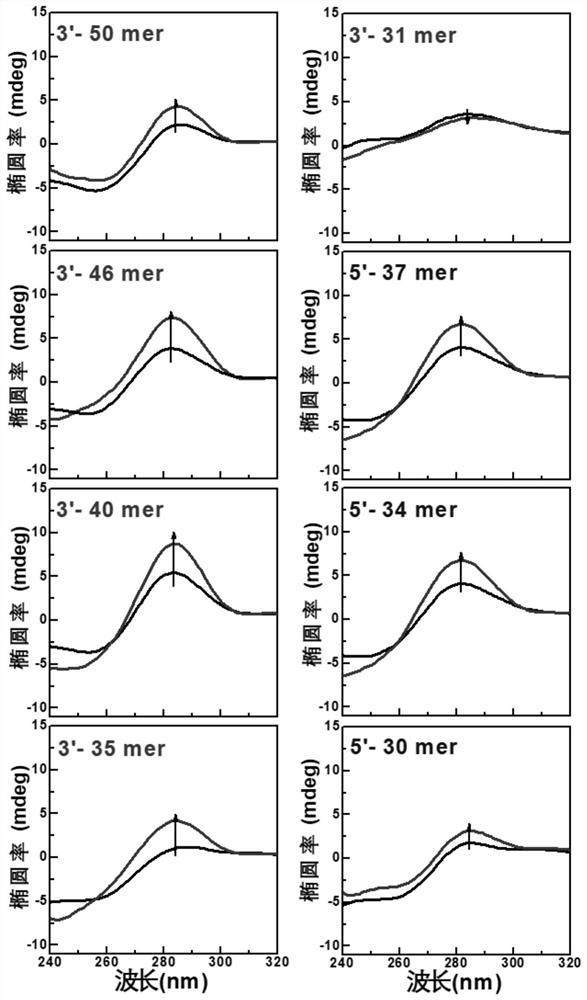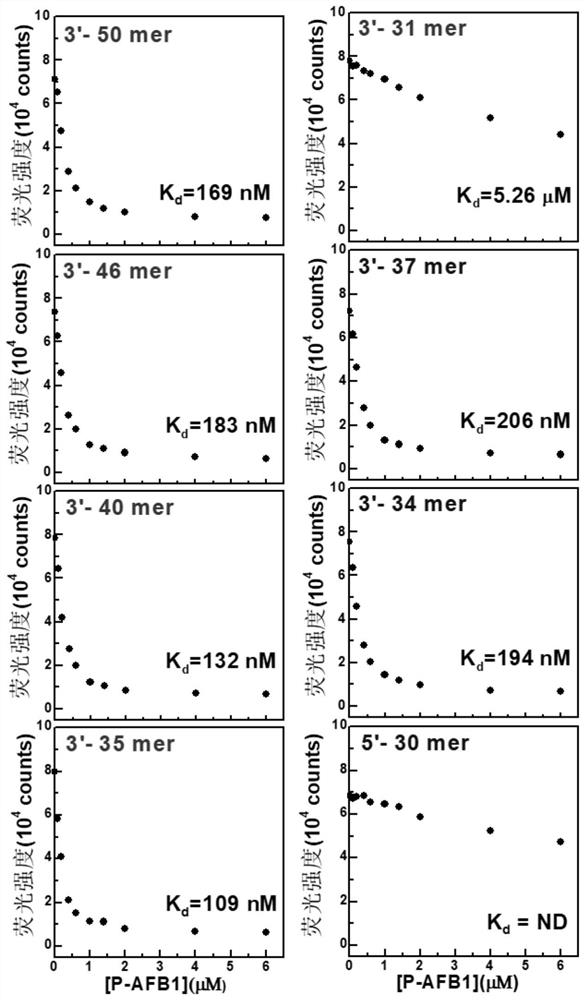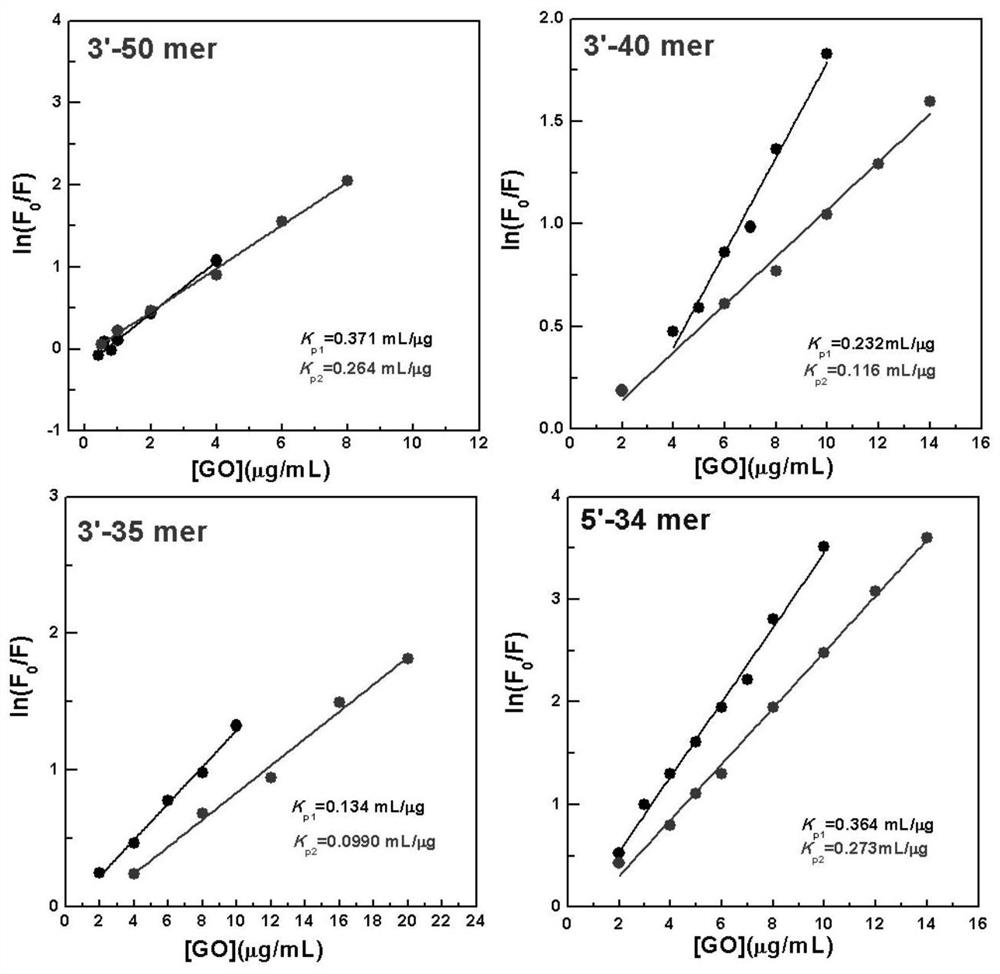Method for Improving the Response Performance of Graphene Oxide-Based Aptamer Sensors
An aptamer sensor, graphene-based technology, used in instruments, scientific instruments, material excitation analysis, etc., can solve problems such as complex interaction relationships and redundant base recognition
- Summary
- Abstract
- Description
- Claims
- Application Information
AI Technical Summary
Problems solved by technology
Method used
Image
Examples
Embodiment 1
[0044] Example 1 Aptamer / GO detection platform detects AFB1
[0045] 1.1 Aptamer truncation
[0046] Base removal design was performed on P-AFB1-50 to obtain a series of truncated aptamers, namely P-AFB1-50, P-AFB1-46, P-AFB1-40, P-AFB1-35, P-AFB1- 31, P-AFB1-37, P-AFB1-34 and P-AFB1-30, the truncated aptamer sequences are shown in Table 1:
[0047] Table 1P-AFB1-50 truncated aptamer sequence
[0048]
[0049]
[0050] 1.2 CD method to monitor the degree of configuration change of truncated aptamers before and after the appearance of the target
[0051] In 10mM Tris salt buffer solution (pH 8.0, 120mM NaCl, 20mM CaCl 2 , 5mM KCl), test AFB1 (1.0μg mL -1 ) CD spectra of P-AFB1-50 chains at a concentration of 1.0 μM before and after appearance. Such as figure 1 As shown, after the appearance of AFB1 in the P-AFB1-50 aptamer chain, the positive peak of the CD spectrum at 283 nm was significantly enhanced. Therefore, CD technology can be used to characterize the inter...
Embodiment 2
[0076] Example 2 Aptamer / GO detection platform detects OTA
[0077] 2.1 Sequence truncation
[0078] The P-OTA-61 aptamer was designed by base deletion, and a series of truncated aptamers were obtained, respectively P-OTA-61, P-OTA-48 and P-OTA-36, the sequences of the truncated aptamers See Table 4:
[0079] Table 4 Base sequences of P-OTA-61 series truncated aptamers
[0080]
[0081] 2.2 Using the CD method to test the degree of configuration change of the above-mentioned truncated aptamers before and after the appearance of OTA
[0082] In 10mM Tris salt buffer solution (pH 8.0, 120mM NaCl, 20mM CaCl 2 , 5mM KCl), the test concentration is 1.0μg mL -1 CD spectra of aptamer chains (P-OTA-61, P-OTA-48, P-OTA-36) at a concentration of 1.0 μM before and after OTA appearance.
[0083] Such as Figure 7 As shown, the addition of OTA to the original aptamer P-OTA-61 solution did not cause a change in the CD signal, indicating that the P-OTA-61 chain has a small degree of...
Embodiment 3
[0096] Example 3 Constructing a dual-channel aptamer / GO fluorescence response platform to realize the simultaneous detection of AFB1 and OTA
[0097] In order to balance the interaction between aptamer chains with different properties and GO, 60nM FAM-labeled P-AFB1-40 and 180nM Texas red-labeled P-OTA-36 were mixed, and then different concentrations of GO were added to the solution to adjust the GO concentration. For optimization, after mixing for 3 minutes, use it to test its fluorescence spectrum.
[0098] Such as Figure 11 As shown, with the increase of GO concentration, the fluorescence intensities at the emission wavelengths of the two channels decreased gradually. When the GO concentration increased to 16 μg mL -1 , the quenching efficiency of P-OTA-36-Texas red reached 95%, while that of P-AFB1-40-FAM reached 80%. Therefore, this experiment chooses 16 μg mL -1 GO was used to construct a dual-channel aptamer / GO composite platform for qualitative and quantitative det...
PUM
| Property | Measurement | Unit |
|---|---|---|
| recovery rate | aaaaa | aaaaa |
Abstract
Description
Claims
Application Information
 Login to View More
Login to View More - R&D
- Intellectual Property
- Life Sciences
- Materials
- Tech Scout
- Unparalleled Data Quality
- Higher Quality Content
- 60% Fewer Hallucinations
Browse by: Latest US Patents, China's latest patents, Technical Efficacy Thesaurus, Application Domain, Technology Topic, Popular Technical Reports.
© 2025 PatSnap. All rights reserved.Legal|Privacy policy|Modern Slavery Act Transparency Statement|Sitemap|About US| Contact US: help@patsnap.com



